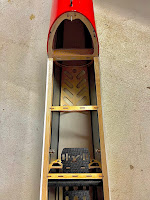Edges are so well loved that they are near the top of almost everyone's list of favorites. With the straight leading edge (LE) to its wing, the Edge is generally accepted to have the best near stall and post stall manners of all. Recently planes like the Gamebird and Velox have narrowed the stability gap, but the Edge is still the benchmark.
This makes the Edge the obvious choice for a lot of people, especially inexperienced 3D pilots. Harrier flight is the building block of all 3D skills, and the Edge does that better than any of them. When you learn 3D, that's where you start, and you need a plane that is good at it. You need a plane that will stay under you and not give you any nasty surprises, and again, this is where the Edge is the best.
In harrier flight you can get wing rocking, which sees the plane drop one wing, and then the other, back and forth. On some planes it can become so pronounced that the plane will eventually veer of to wherever it wants to go, or at best the whole thing just looks sloppy. Better planes will rock a little, but not enough to see the plane go off course, but it still doesn't looks as good as a dead solid stable, wings level harrier. The Edge doesn't suffer from this at all, which makes it ideal for learning harrier.
I learned harrier on an Extra, but it was a good one that didn't rock too badly. It was almost like a rhythmic little dance. The moment I switched to an Edge though, all of that stopped and my harrier got much better overnight. This is the ideal plane for 3D training.
This stability doesn't make the Edge any less capable of precision, snapping or tumbling maneuvers. The precision of this latest Edge was a little surprising. Generally Edges are good here, but the stiffness of the new V2 construction keeps the plane perfectly aligned and tracking straight. We saw this improvement in the 48 Extra V2, but it seems to have helped the Edge in particular.
The Edge still does all of those just great, though shorter coupled planes like the Velox are a little better at the violent moves. Still, unless you want to tumble one into orbit or something, he Edge is still plenty violent enough,
The Edge will still wind itself up tighter in a KE spin than any of the others and is probably the best at pop tops. In waterfall, the edge will rotate over and over on it's wing tube, and it's also probably the best at this.
We've done so many Edge reviews it's impossible not to say the same things over and over. If I wanted to be lazy and dishonest I could just copy and paste the 60" Edge V2 flying report because all of the things I said about that plane are pretty much the same I could say about the new 48". Instead, I'll post a link for you to read at your leisure. Extreme Flight 60 Edge V2__Flight Review
Flight analysis is great, but nothing tells you as much as the flying itself. That's why we have four videos this time instead of our usual two. After a quick shake down and installation hop, I knew what I had. The plane took a notch of up trim, and outside of that I never touched any adjustment on the plane. I checked a few things for tightness, but the way the plane came off the bench is the way I flew it all day. This wasn't me being lazy..... this was a matter of nothing needed changing. The plane came off the bench essentially prefect.
Final piece of advice on this plane, please refer to the Edge build video linked to in the last report. I watched the video a few times and the knowledge gained there really helped make the plane come out as well as it did. Also, follow the set up from the manual, especially the low rates (especially you new guys). You can experiment all you want with set up, but the manufacturers know these planes better than we do and their recommendations are always the best place to start.
Bonus: 48" Edge V2 in white/red






































